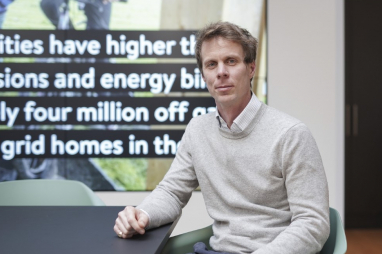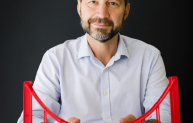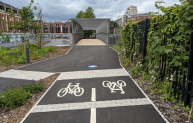Building bridges for a greener future
The climate crisis means there’s never been a more important time to rethink how we build bridges. But it’s not just a simple question of getting from A to B. Buro Happold explains why we need to be both greener and smarter with design – and plan for the future, with its team already hard at work to design London’s lowest carbon crossing.
The road to net zero is undoubtedly a steep one.
With the country facing the 2050 net zero deadline, work must accelerate to decarbonise all sectors of the UK economy – and that includes bridge construction.
Engineering consultancy Buro Happold has been involved with bridge projects across the globe. So, with the clock ticking on the net zero countdown, it is working to bring new materials, new green targets and new ways of thinking to bridge design.
Edmund Metters, the UK lead for bridges at Buro Happold, said: “Meeting required targets is going to be very difficult – and I’m talking outside of just construction, I’m talking across the board.
"There needs to be greater measures put in place, more significant reductions and we need them sooner – industry by industry we all need to take on that responsibility.
“Construction is one of the biggest contributors to carbon emissions – or equivalent carbon emissions – we have a big role to play.
“Waste is one of the large elements in construction, so therefore reducing waste and reusing materials is one of the greatest tools we have to play with. Beyond that, when you are using new, virgin material it’s how to do that with minimal embodied carbon.”
But it’s not just about how a structure is built, it’s important to stop and consider why it’s needed – not just today, but in the future when more of us will be making greener choices, opting to walk, cycle or use public transport and EVs to make journeys.
Metters says understanding the ‘need’ for a project is vital. “Is there a need from a social or economic sustainability argument, if not then why spend the carbon? Do people need to get from A to B and what mode of transport do they need to use to do that? These are the really important questions.”
Buro Happold is using technology to find some of these answers. Agent-based modelling can analyse human behavior, predict the future and maximise the outcomes.
“This kind of modeling allows us to see what would happen if we, for example, made a change from a vehicle bridge to a pedestrian bridge - how many people would choose to get a bicycle or get a cargo bike and take their children to school via that mode of transport?
“Would they stop using their car and walk to work? Technology can think about these scenarios for itself to look at the difference it would make.”
Metters says being able to look today at how things will be done differently in the future to hit carbon targets is vital to be ready for when industry fully embraces the net zero agenda.
“2050 is very close at hand – if we don’t have the evidence and the tools to show how to do it well or do it differently now, we won’t be ready when the clients wake up in five or 10 years' time,” he added.
While green credentials and not just the bottom line are now becoming part of investment decisions, Buro Happold says there is more work to be done – and it is looking to lead by example.
The team is already working on a self-funded full-concept design for a low carbon pedestrian/cycle bridge across the Thames.
But this isn’t a project for a client. It decided two years ago to invest its own time, effort and resources into designing the lowest carbon bridge design it could.
Davood Liaghat, global bridge engineering lead at Buro Happold, explained: “We decided to become more active and take a lead role without a particular client in mind.
“To do so we formed a team including collaborators, Knight Architects, Graham Construction and Gleeds.
“We set ourselves the challenge to make it a low carbon bridge – and made life difficult for ourselves by saying we’d make it across the Thames in the centre of London.”
The team chose a location close to Battersea Power Station having previously been involved in work at the site for Transport for London.
The carbon content for a structure can be calculated in terms of kgCO2e/m2. Some historical bridges have a carbon content up to 6,000kg. Buro Happold has set itself a target of 250kg.
“By looking at design, materials and various aspects we are currently at less than 1,000 and we’re aiming towards 250kg,” said Liaghat.
“We’re doing further work this year, trying to see what we can push it down to.
“We need to do this - rather than just talk the talk we have to walk the walk. Let’s demonstrate it can be done, that’s the way you’re going to convince clients that this is the way we should be going.
“We’re not there yet, but we are getting close. Future materials will come to reduce that figure further.”
The team is looking at considerations such as alternative materials including timber. But it is also looking at requirements for today and the future – as trends are likely to change significantly during the lifetime of any structure.
Buro Happold is also looking at how best to reuse materials rather than rely on raw materials.
Across the construction industry, Materials Passports allow the owner of a product/construction to know exactly what it is made of – to enable re-use of materials in the future.
“There can be too much risk involved in the reuse of material,” added Metters. “As carbon becomes more costly the legal side will catch up.
“If you can influence the way something is demolished, you can have almost new material with an acceptable risk associated with it – that’s also where we need to head towards as an industry.”
But while carbon and cost are vital considerations for any crossing, the public’s emotional response can be fundamental. If something doesn’t look or feel right, all that time, money and effort can be in vain.
“The aesthetics of the bridge can be important – within the context of who uses these bridges or connectors,” explained Metters.
“You can spend a whole load of money and carbon getting it completely wrong and you lose all the benefit. Form and function need to go hand in hand, you need to get that balance right.”
One key example is a bridge replacement carried out by Buro Happold in Kingston.
“There was an existing concrete bridge, but you hardly knew it was there - the access to it was very poorly signposted and it was a thin grey concrete structure.
“The walking count was minimal and hardly anyone used it. We opened it up, with much better approaches, a much wider environment, and we reused a whole load of scrubland that the client was able to lease from Network Rail.
“Without anything other than improving those approaches to the bridge, it’s now an open environment that people want to use, and the connectivity is totally different.
“It’s not even a new structure it’s a replacement structure that reuses the same foundations, but the difference is huge.
“It’s a fantastically positive project and we’ve won some awards for it. It demonstrates that you can spend carbon in a way that influences people’s behavior.
“We should soon be able to estimate the in-use carbon saved due to these behavioral changes compared to the embodied carbon used to replace the bridge.
“The sociability is as important as the technical know-how.”


